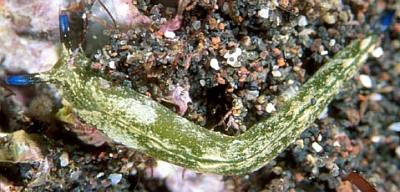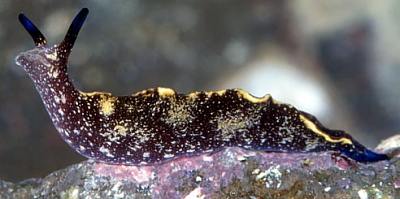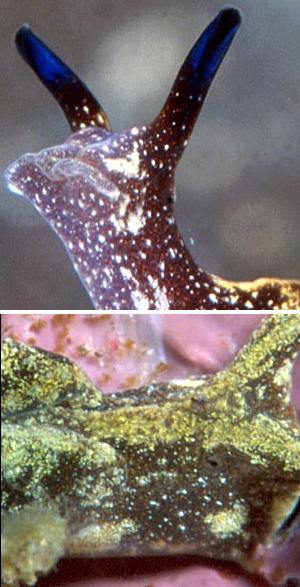On Elysia japonica, E. abei & E. amakusana
September 9, 2002
From: Nishina Masayoshi


Note: Over the last few weeks Nishina Masayoshi has been discussing with me his ideas about these species of Elysia, in particular, E. abei and E. amakusana. His final conclusion is that these 2 'species' are colour forms of the same species. One of the distinctive features of this species are small reddish spots all over the body and sole of foot. Presenting this sort of discussion clearly in English is difficult for an English speaker to do, so what follows is a summary of Nishina's thoughts prepared by me - Bill Rudman.
PHOTOS: Hisako Yamada.
Dear Bill,
Finally, I have clarified my thoughts on E. abei and E. amakusana. I think some of the confusion has been caused because the English section of Baba (1949) [Opisthobranchs of Sagami Bay] is often a rather poor translation of the Japanese.
Here are my translations of the external features from the Japanese:
• Elysia japonica from Baba 1949 [Opi. Sagami Bay - 1st edition]: Grows to 2 cm. The parapodia is narrow. Sometimes, a small number of papillae are scattered on the outside of the parapodia. A corner of the anterior edge of the foot is rather square. The dorsal color is Azuki bean color (reddish brown or dark reddish beige). The features of this animal are, the rhinophores and the tip of the tail are dark violet. Note: this is not Eliot's Elysia japonica. Kathe Jensen has identified Eliot's species as the one I have on the Forum as E. cf. japonica
• Elysia amakusana: In Baba (1955) [Supplement to Opi. Sagami Bay] Baba, renames his Elysia japonica with the new name Elysia amakusana:
"I update the name of E. japonica in Opi. Sagami Bay pp.35, 131; Pl, IX, fig. 27; Text-fig. 25 to E. amakusana Baba. Eliot in describing his E. japonica had only preserved specimens and did not know where they were collected. Although both Eliot's and Baba's 'E. japonica' have black rhinophores and a black-tipped tail, the radular morphology is different."
• Elysia abei: In Baba (1955) [Supplement to Opi. Sagami Bay] Baba, renames his Elysia viridis with the new name Elysia abei. This is complicated however because he considers that he misidentified 2 species as Elysia viridis in 1949.
"I consider the animal shown in Opi. Sagami Bay Pl. VIII, fig.26 in which the rhinophores and the tip of the tail are dyed black ... and with many fine red-vermilion specks scattered on the surface of the body (head, dorsolateral, inside and outside of parapodia and surface of the foot) .. to be another distinct species. Therefore I give a new name Elysia abei". [The animal he identified as Elysia viridis - Opi. Sagami Bay, Pl. VIII, fig.25 - he renames E. hirasei in 1955].
In the reprinted version of Opi. Sagami Bay Baba, (1990) there is a list of updated nomenclature. In this he lists:
E. abei = E. japonica or E. abei (Opi. Sagami Bay,1949, pl.8, fig.26)
E. amakusana = E. japonica or E. amakusana (Opi. Sagami Bay, 1949, pl.9, fig.27).
What do you think? They both have blue and black tips to the rhinophores and tail and the radula morphology is identical. My friends and I used to think that E. abei could be distinguished by the red specks. But we have looked closely at the brown E. amakusana and it also has them, though they are more difficult to see. I have sent as separate messages, photos of a number of different colour forms of this species. As both names were published together, which is the synonym?
Best Regards,
Nishina Masayoshi
nishina@wips.co.jp
Masayoshi, N., 2002 (Sep 9) On Elysia japonica, E. abei & E. amakusana. [Message in] Sea Slug Forum. Australian Museum, Sydney. Available from http://www.seaslugforum.net/find/7784
Dear Nishina,
Thanks for all the photos and time that you and your friends have spent considering this question. I have included the closeup photos, showing the reddish spots, alongside.
Upper: Photo - Hisako Yamada.
Lower: Photo - Nishina Masayoshi.
It is unfortunate that so many species have been described from single specimens, or even decolourised preserved specimens. Elysia japonica is a good example of a species described from preserved specimens. I suspect we will never be totally sure of its identity.
Looking at the photos in this message and your other messages, I agree that this seems to be an example of one variable species. It would be interesting to see whether there is any pattern in the colour forms. Are the brown and green ones on different algae? Are there eggs the same? Do the various colour forms mate with each other?. Before I move all the messages from the E. amakusana page it would be interesting to hear Kathe Jensen's views on the subject. It does seem, however, that Shigeru Hayashi's animals are probably what we are calling Elysia cf. japonica.
Concerning whether we should use E. abei or E. amakusana, I will first have to look at the 1990 reprint of Sagami Bay to see whether Baba actually addressed this question. Under the International Rules it is really up to the first reviser to decide. At present websites such as the Forum are not considered 'publications' for nomenclatural purposes, but since E. abei appears first in Baba, 1955 think it is appropriate to use that name.
Best wishes,
Bill Rudman
Related messages
-
Re: On Elysia japonica, E. abei & E. amakusana
From: Kathe R. Jensen, September 14, 2002 -
On Elysia japonica, E. abei & E. amakusana
From: Skip Pierce, September 13, 2002 -
Elysia abei and E. amakusana
From: Yoshiaki J. Hirano, September 13, 2002 -
Colour forms of E. abei (1)
From: Nishina Masayoshi, September 9, 2002 -
Colour forms of Elysia abei (2)
From: Nishina Masayoshi, September 9, 2002 -
Colour forms of Elysia abei (3)
From: Nishina Masayoshi, September 9, 2002 -
Colour forms of Elysia abei (4)
From: Nishina Masayoshi, September 9, 2002 -
Re: Elysia abei from the Japan Sea
From: Cynthia Trowbridge, September 23, 1999 -
Elysia abei from the Japan Sea
From: Shigeru Hayashi, September 22, 1999
